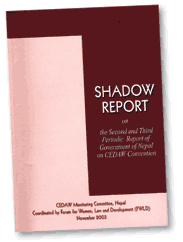 The disparity between the enrollment of boys and girls in Nepal is one of the highest in the world. Nepal has the one of the worst maternal mortality rates, lower even than some sub-Saharan countries.
The disparity between the enrollment of boys and girls in Nepal is one of the highest in the world. Nepal has the one of the worst maternal mortality rates, lower even than some sub-Saharan countries. Why do so few girls go to school? Why do so many mothers die at childbirth? The answer lies in the low status of women in Nepali society, discrimination against the girl child, sometimes even before they are born. And these disadvantages and discrimination are not being addressed meaningfully, and with the insurgency it means the situation of Nepali girls and women is not getting any better.
These alarming facts were presented by a delegation of Nepali women activists this week at the United Nations in New York which is holding the 30th Convention on the Elimination of All forms of Discrimination against Women. Advocate Sapana Pradhan Malla, Dr Chandra Bhadra, Tulasa Lata Amatya, Lily Thapa and Anjana Shakya made the presentations, drawing international attention to specific issues of discrimination against women contained in their 'Shadow Report'.
Although there is an 80 percent enrollment rate for boys in primary schools in Nepal, the rate for girls is only 60 percent. Although girls' enrollment is rising, women's literacy is still 34 percent compared to 75 percent for men and this gap is widening.
The maternal mortality rate in Nepal is 540 for every 10,000, most of which can be prevented with better nutrition and accessible midwife services. Three quarters of Nepali women who are pregnant are anemic, and there is a huge epidemic of prolapsed uterus among women in western Nepal.
 The situation is getting worse due to the conflict, according to the Shadow Report presented in New York. Many women-focussed health programs in western Nepal have been abandoned because of the conflict, making the need greater than ever before.
The situation is getting worse due to the conflict, according to the Shadow Report presented in New York. Many women-focussed health programs in western Nepal have been abandoned because of the conflict, making the need greater than ever before. The report does highlight some of the positive interventions by the government in the past few years in reversing gender discrimination: laws guaranteeing women's right to property, rights against sexual offences, the formation of the National women's Commission and the National Dalit Commission, and compensation to spouses and children of people killed in the insurgency.
However, the report says: "There is a persistence of a strong patriarchal culture that emphasises traditional roles for women and 137 discriminatory provisions in the laws." For instance, Nepali women cannot confer citizenship to their children or husbands, although free education for girls has been announced there hasn't been a notable increase in enrollment, practices like witchcraft and dowry are still prevalent.
An example of one step forward two steps back is the law relating to abortion which was liberalised two years ago to ensure the availability of safe and accessible abortion. But there are still 48 women in various prisons in Nepal serving terms for abortion-related offences. The report says seven more women have been arrested since the laws legalising abortion went into effect.
The report concludes: "Nepali women are discriminated against not only by social and cultural norms, but also by the law because legal provisions still exist which discriminate against women on the basis of sex."


